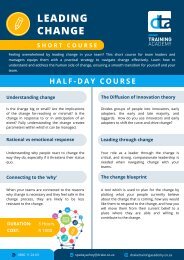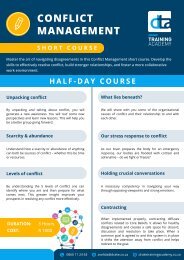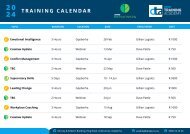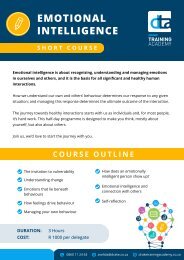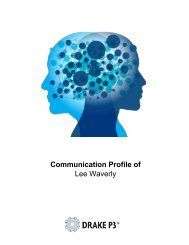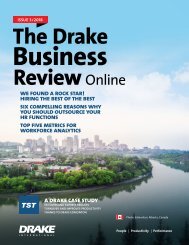Common CV Blunders
You also want an ePaper? Increase the reach of your titles
YUMPU automatically turns print PDFs into web optimized ePapers that Google loves.
Drake Infosheet<br />
9<br />
<strong>Common</strong><br />
<strong>CV</strong> BLUNDERS
Don’t Make These <strong>Common</strong><br />
<strong>CV</strong> Mistakes<br />
Make sure your <strong>CV</strong> is top-notch by avoiding<br />
the top 10 <strong>CV</strong> blunders:<br />
1. Too Focused on Job Duties<br />
One of the most prevalent <strong>CV</strong> blunders is to<br />
turn your <strong>CV</strong> into a dull list of job duties and<br />
responsibilities. Many people even use company<br />
job descriptions as guides to developing their <strong>CV</strong>’s.<br />
To create a <strong>CV</strong> that is a cut above the rest, you<br />
should go beyond showing what was required of<br />
you and demonstrate how you made a difference<br />
at each company.<br />
Provide specific examples of how the company<br />
benefited from your performance. When<br />
developing your achievements, ask yourself the<br />
following questions:<br />
• How did you perform the job better than<br />
others would have?<br />
• What were the problems or challenges that<br />
you or the organisation faced? What did you<br />
do to overcome the problems? What were the<br />
results of your efforts? How did the company<br />
benefit from your performance?<br />
• Did you receive any awards, special<br />
recognition or promotions as a result of your<br />
performance?<br />
2. Objective Statement that is Flowery<br />
or Too General<br />
Many candidates lose their readers from the very<br />
beginning of the <strong>CV</strong>, the objective statement.<br />
The worst objective statements start with, “A<br />
challenging position that will enable me to<br />
contribute to organisational goals while offering<br />
an opportunity for growth and advancement.” This<br />
type of statement is overused and too general and<br />
therefore wastes valuable space. If you are on a<br />
career track, consider replacing the objective with<br />
a tagline, which is a statement of what you do or<br />
what your area of specialty is.<br />
3. Too Short or Too Long<br />
Too many people try to squeeze their experiences<br />
onto one page, because they’ve heard that a <strong>CV</strong><br />
should never be longer than one page. When<br />
formatting the <strong>CV</strong> to fit on one page, many job<br />
seekers delete their impressive achievements.<br />
The reverse is also true. Take the candidate who<br />
rambles on and on for pages about irrelevant or<br />
redundant experiences; the reader will easily be<br />
bored. When writing your <strong>CV</strong>, ask yourself, “Will<br />
this statement help me land an interview?” Only<br />
include information that elicits the answer, “Yes”.<br />
The rule about the appropriate length of a<br />
<strong>CV</strong> is that there is no rule. Factors that go<br />
into the decision regarding length include<br />
occupation, industry, years of experience, scope<br />
of accomplishments and education. The most<br />
important guideline is that every word in the <strong>CV</strong><br />
should sell the candidate.<br />
4. Use of Personal Pronouns and Articles<br />
A <strong>CV</strong> is a form of business communication, so it<br />
should be concise and written in a telegraphic<br />
style. There should not be any use of articles such<br />
as “I” or “me.” Here is an example:<br />
The statement:<br />
I developed a new product that added £2 million in<br />
sales and increased the gross margin of the market<br />
segment by 12 percent<br />
Should be changed to:<br />
Developed new product that added £2 million<br />
in sales and increased gross margin of market<br />
segment by 12 percent
Drake Infosheet<br />
9<br />
5. Listing Personal or Irrelevant<br />
Information<br />
Many people include their interests, such as<br />
reading, hiking, snowboarding, etc. These should<br />
only be included if they relate to the job objective.<br />
For example, if a candidate is applying for a<br />
position as a ski instructor, he or she should list<br />
cross-country skiing as a hobby.<br />
Personal information, such as date of birth,<br />
marital status, height and weight, should normally<br />
not be included on the <strong>CV</strong>.<br />
6. Using a Functional <strong>CV</strong> when there is a<br />
Good Career History<br />
One of the pet peeves cited by hiring managers<br />
is a candidate who describes his or her skills and<br />
achievements but doesn’t connect them with a<br />
particular job. It is irksome not to see the career<br />
progression and the impact made at each<br />
position. Unless you have a <strong>CV</strong> emergency<br />
situation, such as virtually no work history or<br />
excessive job-hopping, avoid the functional <strong>CV</strong><br />
format. One of the most effective <strong>CV</strong> formats is<br />
the modified chronological type. Here is the basic<br />
layout:<br />
• Header (name, address, email address,<br />
phone number)<br />
• Objective Statement<br />
• A strong profile section (detailing the scope<br />
of your experience and areas of proficiency)<br />
• Reverse chronological employment history<br />
(emphasizing achievements in the past 10 to<br />
15 years)<br />
• Education (this might be moved to the top<br />
for new graduates)<br />
• Other related topics include professional<br />
affiliations, community activities, technical<br />
expertise, publications/patents, and<br />
languages spoken<br />
7. Not Including a Summary or Profile<br />
Section that Makes an Initial Hard Sell<br />
A summary section is one of the greatest tools<br />
a job seeker has. Candidates who have done<br />
their homework will know the type of skills<br />
and competencies that are important in the<br />
position. The summary should demonstrate the<br />
skill level and experiences directly related to the<br />
position being sought. To create a high- impact<br />
summary statement, read numerous job postings<br />
to determine what features are important to<br />
employers. Next, write a list of your matching<br />
skills, experience, and education. These selling<br />
points can then be incorporated into the summary.<br />
8. Where are the Keywords?<br />
With the majority of large– and medium-sized<br />
companies using technology to store <strong>CV</strong>’s, the<br />
only hope a job seeker has of being found in<br />
an applicant search is the inclusion of relevant<br />
industry keywords. These do not have to be a<br />
separate section; rather, they can be sprinkled<br />
throughout the <strong>CV</strong>.<br />
A good way to determine keywords is to read job<br />
descriptions for positions that interest you. If you<br />
see industry buzzwords, incorporate them into<br />
your <strong>CV</strong>.<br />
9. References Available<br />
Employers know that if you are searching for a job,<br />
you should have professional references. So this<br />
statement mainly wastes space. Use it only as a<br />
graphical element, to signal the end of a long <strong>CV</strong><br />
or to round out the page design.<br />
10. Typos<br />
One typo and your chances are greatly diminished.<br />
Two typos or more can land your <strong>CV</strong> in the rubbish.<br />
Proofread, proofread, proofread, and show your<br />
resume to several friends to have them proofread<br />
it as well. This document is a reflection of you and<br />
should be absolutely perfect.
Don’t Make These <strong>Common</strong><br />
<strong>CV</strong> Mistakes<br />
UNITED KINGDOM<br />
GLOBAL OFFICES<br />
LONDON<br />
PURFLEET<br />
AUSTRALIA<br />
PHILIPPINES<br />
CHESTERFIELD<br />
STAMFORD BRIDGE<br />
CANADA<br />
SINGAPORE<br />
PICKERING<br />
WEMBLEY<br />
HONG KONG<br />
SOUTH AFRICA<br />
PLYMOUTH<br />
YORK<br />
NEW ZEALAND<br />
UNITED STATES<br />
0800 111 4558<br />
WWW.DRAKEINTL.CO.UK




